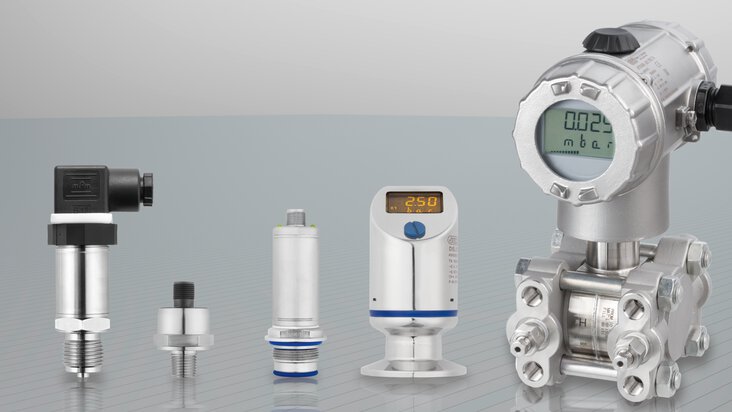
Static and dynamic pressure in fluids
The physical laws of fluid mechanics apply to static and flowing fluids, whereby a distinction is made between static pressure and dynamic pressure. Find out more about the behaviour, possible applications and the differences between the two pressures!
Table of contents
What is the behaviour of static and dynamic pressure?
When fluids are at rest, i.e. when there is no flow, only the static pressure (pstat) acts in them, and it acts equally in all directions.
As soon as the medium flows, e.g. in pipes, the conditions become somewhat more complicated. The kinetic energy increases the force effect in the direction of flow. If this force hits a body that is in the flow, a pressure acts on its surface: this is referred to as dynamic pressure (pdyn), also known as dynamic pressure. This is calculated from the density ρ and velocity v of the medium:
pdyn = ρ/2 ⋅ v2
However, there is no additional force perpendicular to the flow. Only the static pressure acts here. The sum of both pressures is referred to as the total pressure (pges)
ptot=pstat+pdyn
For which applications are static & dynamic pressure relevant?
Static pressure is relevant for most pressure measurements. One exception is flow velocity measurements, which are calculated using dynamic pressure. Examples of applications are speed measurements on aeroplanes or recording the wind speed on wind turbines. In both cases, the Prandtl pitot tube is used, in which the static pressure counteracts the total pressure, whereby the pure dynamic pressure is displayed.

(1) Static pressure
Pressure probe for measuring the static pressure
(2) Static pressure and dynamic pressure
Pitot tube for measuring the total pressure
(3) Dynamic pressure
Prandtl's pitot tube for measuring the dynamic pressure (dynamic pressure)
What does Bernoulli's law say?
To stay with the definition of total pressure, it is important to mention the fundamental law of hydrodynamics, namely Bernoulli's law. This rightly assumes that the sum of static and dynamic pressure is constant along any given flow line.
p + ρgh + (ρ × v2)/2 = constant
The rod p + ρgh is responsible for the static pressure and the rod (ρ × v2)/2 for the dynamic pressure. Since the sum of the two pressures has a constant, unchanging value, one can assume that the pstat pressure decreases when the velocity of the fluid increases. Using the above law, one can calculate, for example, the velocity of the liquid leaving the opening at the bottom of a tank based on the height of the column of liquid in the tank.
Examples of application
The static pressure in a central heating system is an extremely important component for the correct operation of the system. For example, the static pressure should be lower than the opening pressure of the safety valve and at the same time higher than the water column pressure. Knowing the water column pressure is indispensable to avoid system faults and a reduction in heating output.
- ${title}${badge}


